Imagine this:
You are a 35 year old man and your blood pressure is 120/80.
Congrats – your life expectancy is 76 years (assuming you are healthy otherwise).
Now imagine this:
You are a 35 year old man and your blood pressure is 150/91.
Bummer – your life expectancy is 55 years.
Might want to let your kids know about this.
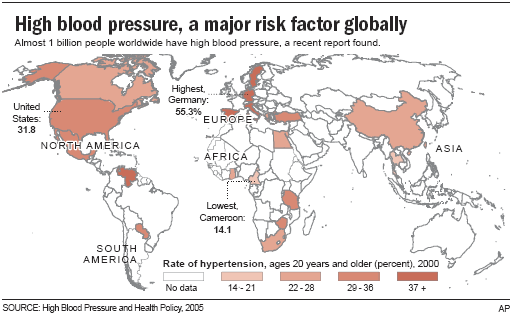
What is high blood pressure?
Think of the water pipes in your house. The pressure in them allows water to flow to sinks, tubs, and washers. Similarly, we need pressure in our blood vessels so that blood can make its way to organs and tissues.
When you’re bumming around Walgreen’s late on a Saturday night and you decide to test your blood pressure, the result comes back as two numbers. The top number is the pressure in your arteries during a heartbeat. The bottom number is the pressure in your arteries while your heart is resting between beats.
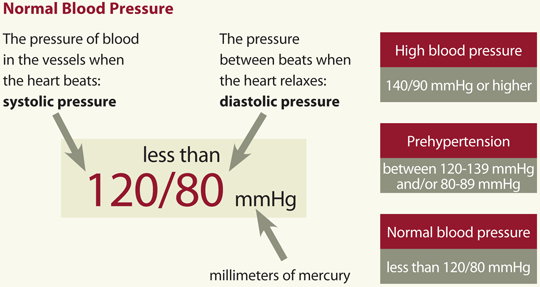
Our bodies can regulate blood pressure in various ways.
- Pressure receptors in organs adjust the force and speed of the heart’s contractions. For instance, when you go from lying down to standing, pressure receptors sense this and trigger a brief increase in heart rate to keep everything from sloshing into your feet.
- The kidneys and adrenal glands adjust components in blood that influence blood volume and fluid balance. Anti-diuretic hormone (ADH) decreases urine production. Aldosterone increases reabsorption of sodium (in exchange for potassium) from the urine, sweat, saliva, and intestinal secretions. This draws fluid back into your body and increases blood volume and blood pressure.
- Receptors in blood vessels adjust their size and elasticity.
Why is high blood pressure a problem?
Just like water pipes, if the pressure is too high or too low, you have problems. Imagine trying to use a garden hose to handle the pressure of a fire hose. That gives you an idea of what happens to your blood vessels.
If the pressure in your vessels is too high each time your heart contracts, damage can result.
- If this damage occurs to vessels of the eye, you could end up blind.
- If this damage occurs to vessels of the kidneys, you could end up on dialysis.
- If this damage occurs to vessels of the heart, you could end up with a heart attack.
- If this damage occurs to vessels of the brain, you could end up having a stroke or developing Alzheimer’s.
- If this damage occurs to vessels in the legs/arms, you could end up with peripheral vascular disease.
For each increment of 20 mm Hg (a measurement of blood pressure), cardiovascular disease risk doubles.
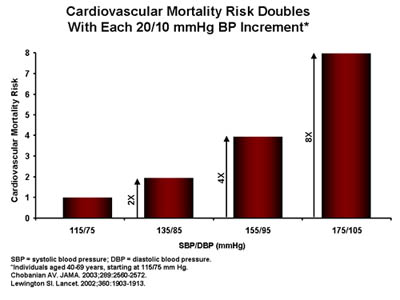
High blood pressure and preventable deaths
In 2005, 395,000 Americans died due to high blood pressure. In terms of individual risk factors for preventable health conditions, only smoking causes more deaths.
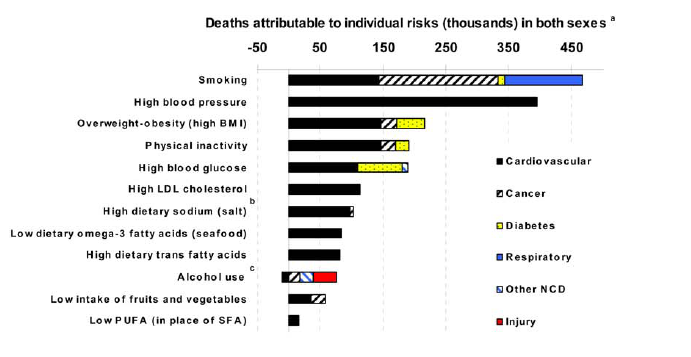
High blood pressure doesn’t affect everyone equally. Your risk can also depend on your sex, age, and racial-ethnic background. For instance, women are more likely than men to suffer from high blood pressure if they are older.
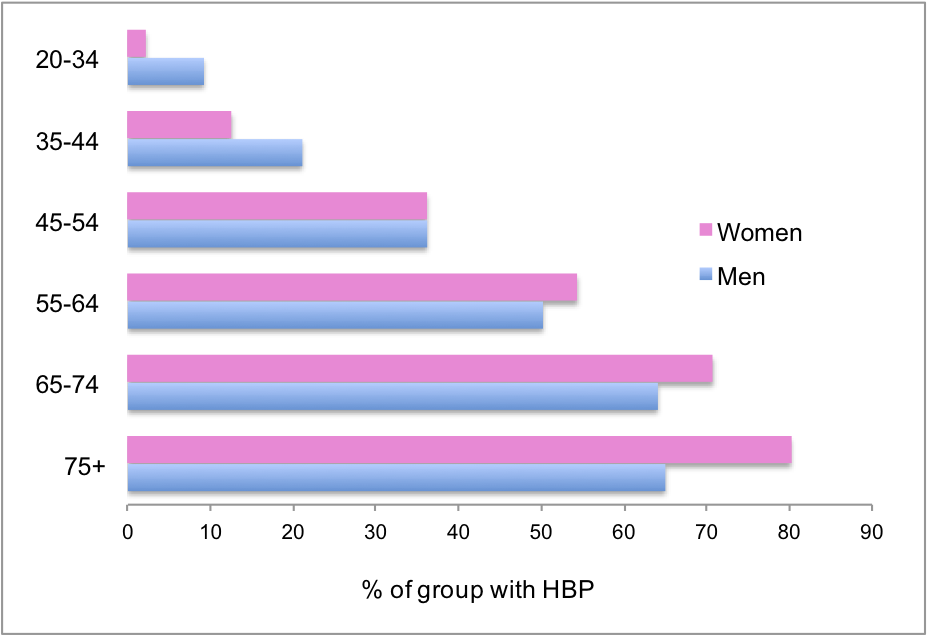
In the US, African Americans have far higher rates of high blood pressure than Mexican Americans or whites. Here again, women are slightly more likely to have high blood pressure… unless they are white.
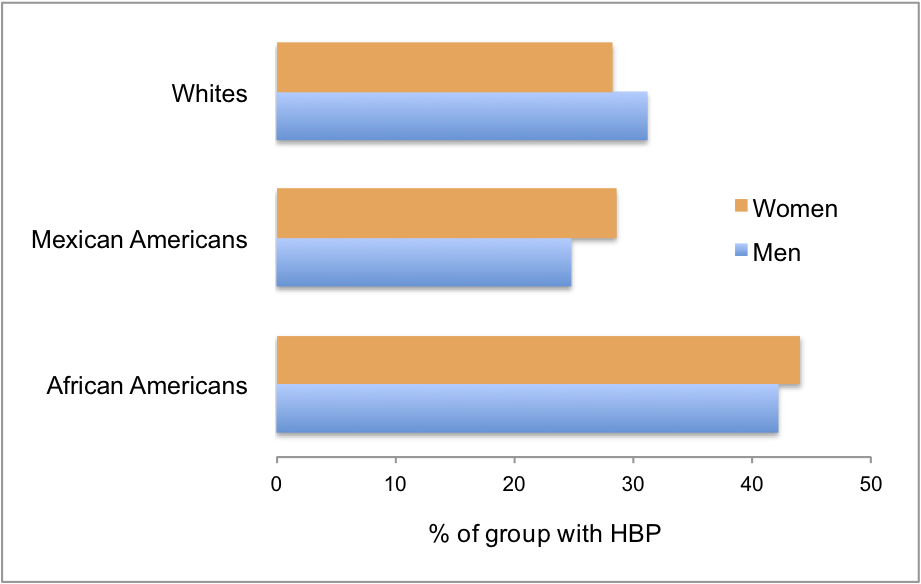
How to get high blood pressure under control
It’s pretty clear that high blood pressure is not only a health risk in and of itself, but it also signals the presence of other underlying health problems.
If you’re American, about 1 in 3 of you has high blood pressure. But you feel fine? That’s because high blood pressure doesn’t have any symptoms. You could be at risk without knowing it.
So let’s talk about controlling it. Luckily, the things that control blood pressure also keep you lean and fit. It’s win-win!
Lose body fat (or stay lean)
Rule #1 for controlling blood pressure is stay lean. Extra fat on the body needs extra blood vessels. And fat cells produce substances that promote inflammation throughout the vessels and heart. Use the eyeball test here. If you look fat, you are fat.
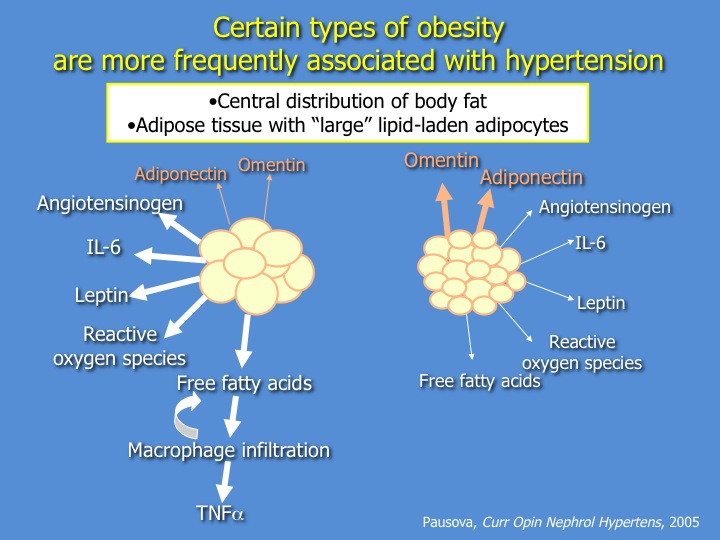
Move your body
Bad news – if you don’t regularly move your body, your risk of high blood pressure can go up by 60%. Any type of regular physical movement is helpful here (except moving your hand from the bag of chips to your mouth). Exercise seems to be even more important for men.
Doing structured workouts can be especially effective in helping to lower existing high blood pressure. We’re talking at least 5 hours of exercise per week. And (up to a point) more is likely better. Just because you clean up the bats for the company softball team doesn’t mean you are moving your body enough to control blood pressure — check yourself.
All forms of exercise are useful here (including short bouts, long bouts, and resistance training).
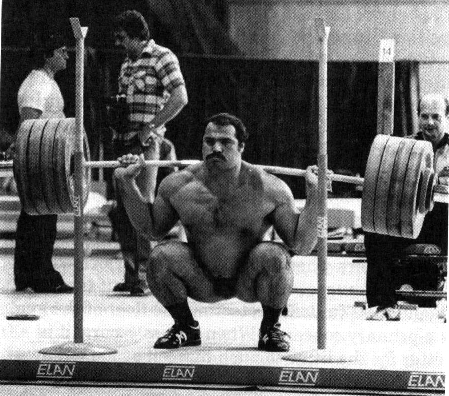
However, if you already suffer from high blood pressure, use caution: Maximal resistance training and using the Valsalva maneuver can bump up blood pressure during lifting. If blood pressure is a concern for you, opt for shorter sets with longer rests, and watch your heart rate between sets. (Maybe squat only six plates instead of eight.)
Exercise helps to control insulin levels. Less insulin means less sympathetic nervous system activation, less sodium reabsorption in the kidneys, and more elasticity in blood vessels. Exercise also makes your heart more efficient.
Exercise alone can lower blood pressure by nearly 4 mm Hg (even without any concurrent weight loss). A 5 mm Hg reduction in systolic BP can mean a 7% reduction in all-cause mortality. That’s a good first step.
Dump the boozing and smoking
Alcohol has a somewhat contradictory relationship with blood pressure. A little of the right type, enjoyed slowly and socially with a good meal, seems to help. About one alcoholic beverage per day — especially red wine — can lower blood pressure slightly (especially in women).
However, more is not better. Lots of booze leads to lots of blood pressure.
And if you guessed that binge drinking on an empty stomach might not help control blood pressure, you are correct. High alcohol intake can:
- activate the sympathetic nervous system
- activate the renin-angiotensin-aldosterone system (which controls fluid levels in the body)
- increase levels of stress hormones such as cortisol
- decrease production of nitric oxide (which normally helps relax blood vessels, so if you have less nitric oxide, your blood vessels are going to be as pliable as frozen rubber)
These are all bad things for controlling blood pressure.
We all know smoking is bad. Smoking increases blood pressure, so you might want to find a new hobby.
Improve your nutrition
Diets built around whole, unprocessed plant foods can help control blood pressure. People with existing high blood pressure who add more plants to their diets can lower blood pressure into a healthy range — even if they don’t lose weight.
Eating more plants improves your intake of arginine, lycopene, folate, fibre, magnesium, potassium, sulfur, and vitamins C and E. All of these nutrients play a role in controlling blood pressure.
But wait a second, what if someone just consumed a Western diet while supplementing the aforementioned nutrients? Well, this might help a smidge, but not enough to impress your blood vessels.
Pressure-lowering plantsPlant foods rich in arginine: lentils, chickpeas, black beans, pumpkin seeds, peanuts, Brazil nuts, coconut, walnuts, almonds, sesame seeds Plant foods rich in lycopene: tomatoes, grapefruit, salsa, watermelon, guava, baked beans Plant foods rich in folate: leafy greens, lettuce, asparagus, broccoli, cauliflower, beets, lentils Plant foods rich in fibre: beans, peas, nuts, seeds, whole fruits, whole vegetables, whole grains Plant foods rich in magnesium: black beans, broccoli, peanuts, okra, pumpkin seeds, soybeans, spinach, oats, artichokes, banana, barley, buckwheat, navy beans, corn, raw chocolate (aka cacao) Plant foods rich in potassium: apricots, avocado, banana, beets, potato, dates, melon, Brussels sprouts, oranges, pears, peanuts, raisins, spinach, squash Plant foods rich in sulfur compounds: garlic, onions, leeks, brassicas (cabbage, broccoli, Brussels sprouts, cauliflower), nuts; onions and garlic in particular are high in sulfur compounds that increase nitric oxide production Plant foods rich in vitamins C and E: green leafy vegetables, broccoli, potatoes, peas, oranges, mango, olives, avocado, tomatoes, apples, carrots, nuts, seeds, whole intact grains |
Here are 8 important dietary changes you can make to lower your blood pressure.
1. Consume 1-2 servings of lower fat dairy each day
.
Higher fat dairy doesn’t seem to have the same effect. Some studies suggest that dairy might help to moderate insulin levels, although the evidence is mixed — other studies have shown that dairy can be insulin-stimulating. Additionally, research suggests that peptides released with cow’s milk can inhibit angiotensin converting (ACE) enzyme, while a clinical trial showed that hydrolysate of casein lowered arterial blood pressure.
2. Get plenty of lean protein.
Protein dense foods help control insulin release. Plant proteins like beans/legumes are also good substitutes for more refined carbohydrates.
3. Consume at least 3 servings of intact whole grains each day.
This means whole grains such as brown rice, whole oat groats, sprouted grain bread, quinoa, etc. Whole grains can improve blood vessel elasticity.
4. Consume 10-30 grams/day of dark chocolate.
Compounds in cocoa may help blood vessel elasticity. Plus, it makes you feel groovy, and reducing stress is a great way to lower blood pressure!
5. Get enough vitamin D.
Vitamin D deficiency is associated with high blood pressure. Get blood levels tested and supplement if necessary. And get outside for some sunlight, cubicle moles! See All About Vitamin D for more.
6. Balance your fat intake.
Get plenty of omega-3s from oily fish (and other marine life), wild-caught game meats, and flax (ALA, EPA and DHA all seem to help – see here for more: All About Healthy Fats). High omega-3 intake is linked to lower blood pressure, likely because of omega-3s influence on eicosanoid production, which helps control vessel dilation and platelet aggregation.
7. Cut the sugar.
Americans eat about 22 teaspoons of added sugar per day, which might be contributing to our rampant high blood pressure. Excess sugar can make us fat, which can lead to high blood pressure.
And eating lots of added sugars may also activate the sympathetic nervous system, decrease urinary sodium excretion, increase sodium absorption in the GI tract, and decrease blood vessel nitric oxide. Not good.
8. Supplement wisely — once your diet is excellent.
Once you have everything else under control, you can look into supplementing things like Coenzyme Q10 and/or garlic.
Cut sodium intake…
It’s well established that dietary salt plays a role in regulating blood pressure. More sodium means higher blood pressure; conversely, lowering sodium lowers blood pressure too.
But don’t fear sprinkling a little salt into your homemade lentil soup. When we talk about over-salted Americans, we’re talking about processed foods and restaurants. About 80% of the sodium we consume comes from processed foods.
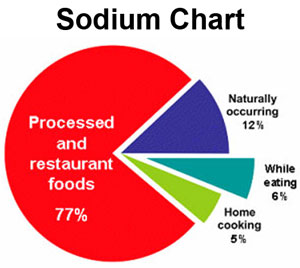
Going from standard salt-laden American eating (about 6,000 mg of sodium per day) to consuming under 2300 mg of sodium per day can lower blood pressure 10 points in hypertensive folks, without any other changes.
…but not too much
We need some sodium, especially if we’re active. We need at least half a teaspoon of salt each day for normal functioning. If you are really fit and lean, you can get by with about 1 teaspoon of daily added salt.
Cutting salt too much when you don’t need to isn’t a good idea. If you exercise and sweat a lot, you need more. And folks getting restrictive with salt intake are at risk for iodine deficiency. For more on sodium, see All About Sodium.
Many folks get hyper-focused on salt when it comes to blood pressure. But we all respond to it differently. A high salt intake is usually just a symptom of a crappy overall diet – too many processed foods, sugar, dairy, meat – and not enough vegetables, fruits, beans, whole grains and nuts/seeds (potassium from plant foods helps to balance the effects of sodium and keep blood pressure in check).
Yoga, meditation and stress
If you’re always stressed, your blood pressure is probably elevated.
Deep breathing, yoga, and meditation can immediately lower blood pressure by several points. But it’s not enough to be stressed out all week and hit a Sunday yoga class. You need to relax more overall. Five minutes of deep breathing can only do so much when the other 10,075 minutes in your week are hectic.
So make it a priority to chill out. Pet a dog, see a therapist, take a nature walk, meditate, listen to music, do yoga, see a comedian, or anything else that helps you get mellow. Your health may depend on it.
Summary and recommendations
Blood pressure can almost always be controlled with lifestyle changes. Just remember, small changes = small results. Big changes = big results.
- Stay lean. If you look fat, you are fat.
- Get 5 hours/week of exercise. At least some of it should be vigorous.
- Move around during the day. Use your body to get places.
- If you drink alcohol, keep it around one drink per day. Wine is best, and try to consume it with meals.
- Don’t smoke.
- When you sit down to eat, make sure that most of your plate/bowl is filled with vegetables, fruits, beans/peas, intact whole grains, and nuts/seeds. Including small amounts of lower fat dairy and dark chocolate each day might help.
- If you regularly eat added sugars and salt, your diet probably sucks. Cut them where you can and replace with veggies or fruits.
- Consume oily fish and other marine life. Mix in some flax seeds, hemp seeds, chia seeds or walnuts to get your dietary omega-3’s.
- If you are vitamin D deficient, use a supplement. Get outside in the sun.
- Bust stress. Do yoga, breathe deeply, connect with loved ones, laugh.
Extra credit
Lots of caffeine can bump up blood pressure. Though tea and coffee have mixed results on blood pressure (probably due to genetic differences in caffeine metabolism), you don’t need to chug them anyway.
Different types of religious fasts seem to have variable effects on blood pressure. No style of fasting appears to have a clear benefit.
Binge drinking increases both systolic and diastolic blood pressure by about 5 mm Hg during the time of intoxication.
Systolic blood pressure readings in excess of 300 mm Hg have been recorded during the leg press. In the 1-3 hours after exercise, systolic blood pressure tends to decrease by 10-20 mm Hg. This can last up to 9 hours. So if you’ve ever stood up too fast after a set of heavy squats or while cooling down from a workout and felt dizzy/saw floaters, then you’ve experienced this.
Early AM hours and cold weather can result in a higher blood pressure.
Certain medications can raise blood pressure – check with your doc.
The blood pressure levels of purely vegetarian Trappist monks were found to be lower than those of Benedictine monks, who consume a Western diet.
Adding more meat to a plant-based diet increases blood pressure, possibly from the “substitution effect” (swapping out blood pressure lowering plant foods).
References
Click here to view the information sources referenced in this article.
Eat, move, and live… better.©
Yep, we know… the health and fitness world can sometimes be a confusing place. But it doesn’t have to be.
Let us help you make sense of it all with this free special report.
In it you’ll learn the best eating, exercise, and lifestyle strategies – unique and personal – for you.




Share